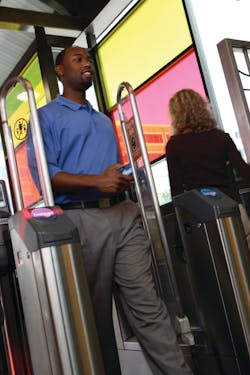With transit technology continuing to evolve on an almost daily basis, transit agencies are not seeing a shortage of data.
Each minute a system is operating, a constant feed on passenger data, train data, bus data, stop data, maintenance data, weather data, customer count data and countless other forms of data are streaming into transit system computers and getting filtered through to administrators and supervisors to make decisions on how to better run the system. However, with numbers and data continuing to flow in to agencies, some might even paralyze themselves from the sheer amount of information coming into them on a given day.
“You have to look from top down,” Fred Wedley, senior director of transit and rail tech services for CH2M Hill said. “Each corporation has goals and those goals are key performance indicators supported by information that is visualized in various forms.”
In 2005, the Metropolitan Atlanta Rapid Transit Authority (MARTA) switched to a smart card fare system known as Breeze, which has riders scan their cards to enter buses and rail, and scan their card in order to exit rail stations.
Hubert Gee, director of revenue operations for MARTA, said they use the data to track where revenues are being collected in the system and data patterns from partner transit systems—Georgia Regional Transit Authority, Gwinnett County Transit and Cobb County Transit.
“With Breeze, of course we track taps at the fare gates at the rail system and taps on the bus system,” Bob Thomas, director of transit analysis for MARTA said. “But we don’t necessarily take that few frames of data as the gospel of the truth.”
Dave Brown, AFC senior program manager for MARTA, said system leaders also use data from larger events, such as the Atlanta Falcons playing in the NFC championship game in January to track the amount of riders going to the larger events. Information is also used at smaller levels, such as determining which gates get the most use to determine when it may need maintenance.
“In addition, we use it for fare policy and fare setting,” Brown said. “We can tell what products are used more and how to set fares accordingly.”
Thomas stressed the conversion to a smart card fare system takes time to get data from the system, taking more than a year for MARTA to finally see data results. However, the data collection brought in from being able to track fares has allowed MARTA to make adjustments by tracking customer habits. For example, Thomas said MARTA discovered a shift in the length of passes being used by customers in the past year. The amount of people opting for longer passes, such as a 30-day pass or seven day pass are now opting for one or two day passes, or just store certain amounts of money.
“In December of 2005 when we first started putting equipment out there, it was really more of a process,” Thomas said. “It took a longer period of time than a few weeks to get out there and start acquiring data from the equipment.”
Thomas said MARTA has also started tracking smart fare data and comparing to automated passenger counters on buses in order to compare the data as part of a system sustainability initiative.
Todd Plesko, vice president of planning and development for Dallas Area Rapid Transit (DART), said that system tracks various forms of data, such as bus location to track routes and to check customer complaints. If customers complain about a later bus or some other issue, Plesko said tracked data allows for DART officials to find out who the bus operator was, on-time performance for the route and to actually determine if the bus was later or if the head sign was wrong. Counters are also used on trains as well and track their performance and use a cab control system to automatically shut a train down if the operator doesn’t respond, fails to heed speed warnings or encounters another issue.
Plesko said DART officials were recently using data points to solve another rail issue where a train was doing a series of fast stops, causing the wheels to lock up and create flat spots. Using data points surrounding the conditions of the fast stops DART officials looked into the matter to try and determine the root cause of the issue.
“That’s not a typical issue I’ve seen in the transit system, but hopefully we don’t have those problems anymore,” he said.
Mike Wilson, managing director of public transportation for North America at Accenture, said technology is making it easier for transit agencies to get lots of data from all different aspects of their operations, but utilizing it properly is still a big issue.
“One observation I’ve had is there’s not really a lot of data driven cultures. It’s kind of sporadic amongst the agencies and within the agencies,” Wilson said. “I don’t think a lot of people are used to the idea of taking data and how to each use it effectively. It’s that culture that still needs to be worked on to help take advantage of it.”
Wilson said some agencies will fail to transfer data with each other and lack transparency and even fail to have an appreciation for the people riding their buses or trains. Sometimes leaders will even ignore certain data points while trying to figure out a trend or issue, Wilson said, in order to prove something they believe to be true.
He said some agencies will also purchase data collection systems and find out after the fact that it’s a closed or proprietary, which can’t provide the visibility or access to data they want to track.
Taking data to a new level
Tracking boarding data in order to study customer habits is being taken to new levels with new advances in both fare collection and security allowing richer information to reach and even helping other non-transit agencies. Brown said the data being collected by MARTA is now reaching beyond transit, with the agency building a database warehouse and sharing its information with other regional agencies and Google, who can use the information for their own analysis in trends.
Wilson said a study of data looking at those taking transit in Toronto and Ottawa showed regular customers would spend an additional $30 per week on other goods such as coffee and newspapers. Information like that can help agencies better target partnerships with commercial entities or when working on future station designs.
Wedley said asset management is also getting more attention for data collection with British-created PAS 55 standard leading to the development of ISO 55000 to dictate asset management for transit agencies.
“A really hot topic right now is asset management date for rail lines and buses," he said. “That way, No. 1, they can replace them as they’re needed before they fail and No. 2, most importantly, you can keep your stock maintained by performing preventative maintenance and also you’re keeping your assets at the right level by not over-purchasing or under-purchasing.”
Plesko said audio video data collected by security cameras is something DART is looking into using more to help with safety along lines in Dallas and crime information collected from police agencies is allowing DART to determine how to make safer environments for customers by changing shelters or providing more light in areas where someone may be subject to a crime.
“I think that as a country, we’re pretty good and buying the cameras, but when it comes to using the information, we’re not quite there yet,” he said.
New Revenue generation
Some larger transit agencies are now shifting to open fare systems where riders can pay for rides via a credit card, smart card or mobile device, such as a cell phone, which is opening up yet another line of data for transit providers. Wedley said the new fare systems are going to provide even more data, which systems will need to sift through so they provide better access to customers and improve routes.
One of the shortfalls of riders paying cash or a day pass is that transit officials can only track when a rider gets on, but doesn’t know where they get off or who they are. But DART is implementing new technology to offer riders the ability to use smart phones to pay fares, which Plesko will have riders register with the system and allow DART more direct marketing to the rider. Plesko said the system does a lot of surveys of riders and the information collected and new information collected via the targeted surveys and registrations could provide the “holy grail” of information to marketing workers.
“DART knows if you use it for special events, you might also be interest in DART for St. Patrick’s Day, or maybes some other purpose,” Plesko said. “But a lot of times we find that people who use it for these events are infrequent users. Let’s say maybe there are 250,000 daily boarding’s on a transit system and maybe that’s about 90,000 people, so some of them are infrequent users who we think could be turned into more frequent users, but you don’t know their name or how to get in touch with them and that becomes a problematic experience.”





